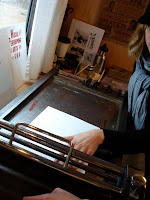A few weeks back Boston University's Stephen Prothero wrote a piece for the Wall Street Journal, "Memorial Day and the American Bible." For Prothero, the notion of the "American Bible" has less to do, ultimately, with the texts of Scripture, and much more to do with the texts of our identity. The "American Bible" is comprised of those texts that help to answer the question, "What is (and is not) American?":
Americans [share] a collection of core texts that "we the people" regard as authoritative and a long-standing tradition of debating what these texts have to tell us about the meaning of "America"... This unofficial canon includes founding documents such as the Declaration of Independence and the Constitution as well as songs such as "God Bless America" and speeches by Washington, Lincoln, FDR and Reagan. It also includes novels from "Uncle Tom's Cabin" to "Atlas Shrugged."For Prothero, it is the constant state of debate over this canon, and what it means, that is the most constant marker of what it means to be "American." Not the adherence to a certain political position, so much as the commitment to the struggle of pluralism among political positions. "Look Lincoln in the eye and tell him that liberty, not equality, is America's founding proposition. Tell King you have a different dream. But as you criticize these men, know what you are doing. You are not opting out of America; you are opting in," writes Prothero.
Prothero's hypothesis about the "American Bible" is much akin to what Jim Watts and Dori Parmenter have been saying for the past several years about the status of "Iconic Books" in national (not just American) consciousness. Indeed, Prothero's observation that "What makes these texts American scripture is not so much that Americans call them sacred or treat them like sacred objects (though in many cases we do both). What makes them scripture is the fact that Americans use these texts like Christians use the Bible," resonates strongly with Parmenter's work and Watt's "The Three Dimensions of Scriptures."
I find it especially interesting that this article appeared in the Wall Street Journal. I think it is a wonderful forum in which to raise the questions Prothero is pursuing. Unfortunately, from my glance at the comments section, the readers seem unwilling or ill-equipped to engage the issues Prothero has presented. Instead, there seems to be a preoccupation with the "atheism" of Obama and the "socialism" of our current policies, with little in the way of evidence or grammar in support.
But, at the end of the day, I suppose this only strengthens Prothero's main point. In abundant amounts, disagreement seems to be the quality we, as Americans, most universally share.



